



Even a single missing tooth can lead to multiple problems over time for a person’s confidence and oral health, and these issues only worsen as more teeth are lost. If missing teeth are making it hard for you to smile confidently or eat your favorite foods, then you’ll be happy to know that our team at Warnick and Semder Dentistry has just the solution you need: dental implants in St. Albans, WV. Dental implants go one step above traditional options by recreating the root structure of the tooth, leading to a replacement that feels more comfortable, looks more natural, and lasts longer. Our dentists can even complete the dental implant process entirely in-house for added convenience. Contact us today to learn more about this comprehensive, long-term solution to tooth loss!
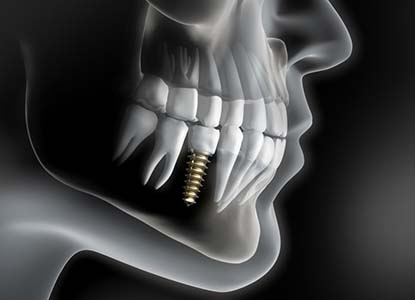
A natural tooth has two parts: the crown that you can see, and the root that is embedded under the gumline and in the jawbone. Traditional tooth replacements like dental bridges and dentures only bring back the crowns of missing teeth because they simply rest on top of the gums. Dental implants, on the other hand, replicate the entire tooth structure for a more lifelike solution.
A dental implant refers to a small, screw-shaped titanium post that is surgically placed into the jawbone where a missing tooth’s roots once were. Titanium is biocompatible, so the implant encourages the jawbone to grow around it until it basically becomes part of your anatomy. Above the gumline, we install a small connector piece called an abutment onto your implant, which can support a dental crown, bridge, or denture, depending on the number of teeth you’re missing. In the end, you have a complete smile that looks, feels, and functions just like it did before tooth loss!
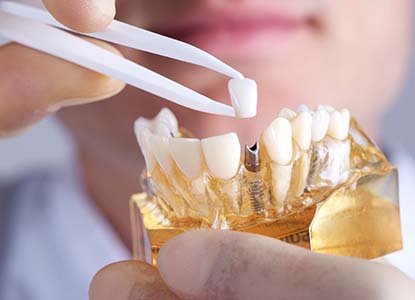
Unlike many general dental offices, our dentists are experts in every stage of dental implant treatment. You can get the entire process completed under one roof! This makes your appointments more convenient and makes communication of your needs easier within our dental office.
As part of your consultation, we’ll go over all of your specific needs in greater detail. Most patients experience the same four basic steps of the dental implant process: the consultation, dental implant surgery, osseointegration, and the placement of your final restoration.

The comprehensive structure of dental implants enables them to provide a tooth replacement that has longevity, incredibly natural esthetics, stability, and restorative benefits. After the implant has integrated with your existing bone tissue, you can expect your tooth replacement to last between 25 years and a lifetime. Just make sure to practice daily oral care and avoid tobacco products at all costs.
Furthermore, eating the foods you enjoy doesn’t have to be a struggle when you have dental implants. Even tough or crunchy foods like steak or apples are easy to eat with dental implants! And, because blood flow and bone stimulation are taking place after an implant restores your smile, you can avoid premature facial sagging of your face and maintain the most amount of biting force possible.
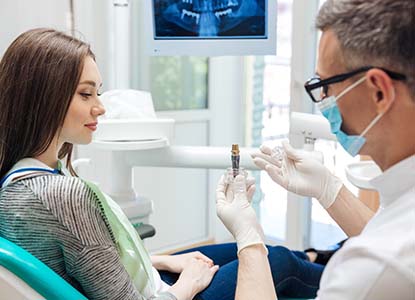
Practically any healthy adult who is looking to replace their missing teeth can benefit from dental implants. Whether you’re lost one, a few, or all of your teeth, there’s a way that we can help! We’ll come up with a unique treatment plan based on the extent of your tooth loss.
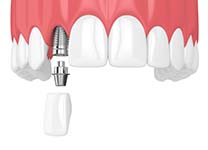
Replacing a single tooth requires only one titanium implant placed inside of the jaw, which is then given time to heal. After all of your oral structures have healed around the implant, a porcelain crown is placed on top of an abutment, which connects the components together.
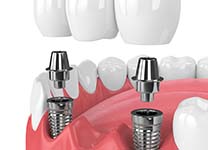
Replacing multiple consecutive teeth can be done with an implant-supported bridge. Instead of relying on existing teeth to hold the bridge, which would require removal of tooth enamel, implant bridges use a pair of dental implants to hold either a three- or four-crown bridge. Through this method, you can expect a more stable and reliable restoration.
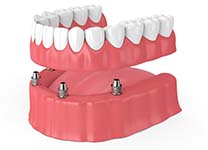
Fitting a series of dental implants with a full denture is a surefire way to create a more reliable and stable fit overall. Plus, we only need to place four to six dental implants to hold a full denture, so your treatment is not nearly as complex as you might initially expect. With implant dentures, you can enjoy replacement teeth that stay firmly in place and restore more chewing power than a conventional prosthetic.

No two dental implant treatments are created equal, which is why determining the price of your tooth replacement must start with a detailed consultation. During this appointment, we’ll discuss all of your needs, including the number of implants you need placed, the type of restoration(s) you need to restore your smile, and the preparatory treatments that may be necessary before dental implants can be viable. Even though treatment can be expensive, dental implants are considered to be a long-term investment that lasts for decades, which cannot be said for other forms of tooth replacement.

After your dental implants have been placed, it's important to follow these recommendations to ensure their long-term success.






To further reduce discomfort after the first 24 hours, you can rinse your mouth very gently three times a day with warm salt water. Use about one teaspoon of salt per glass of warm water.
I Need a Checkup & Cleaning I Have a Cavity or Broken Tooth I am Looking for a Dentist for My Child I am in Pain & Need Help I am Missing 1 or More Teeth I Want to Enhance My Smile I Experience Head, Neck & Jaw Pan I Would Like a Straighter Smile I am Interested in Botox® I am Afraid/Anxious of the Dentist View Our Services